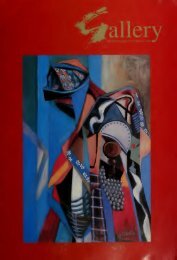Untitled - gallery delta
Untitled - gallery delta
Untitled - gallery delta
You also want an ePaper? Increase the reach of your titles
YUMPU automatically turns print PDFs into web optimized ePapers that Google loves.
Barbara Murray takes a closer look at the work of Keston<br />
Beaton, one of Zimbabwe's most under-estimated artists<br />
listening to<br />
sculpture<br />
A rubbish heap is a good place to gain knowledge. Archaeologists, for<br />
example, use the layers of refuse left behind by inhabitants to provide<br />
scientifically acceptable evidence of lifestyles, values and systems.<br />
Using found objects as their source material, contemporary artists have<br />
become archaeologists, historians, sociologists and, in Zimbabwe, Keston<br />
Beaton is one such masterly gatherer of the evidence.<br />
He seems to have taken to heart the advice of that great poet and<br />
playwright. Bertold Brecht: "Use whal you can." Ignoring commercial<br />
pressures, local expectations of 'art' materials and prejudice against<br />
'rubbish". Beaton sifts through random, broken, discarded and displaced<br />
bits and pieces, combining them to make new and original wholes which<br />
have their own logic and beauty.<br />
Keston Beaton is a connective artist, working in contemporary mode but<br />
along an old artistic line which stretches back to the bricolage of classic<br />
African artifacts. To conventional materials such as wood, metal and<br />
stone he adds modem ingredients such as plastic, rubber, glass and<br />
cardboard. Within each material he has moved away from handcrafting<br />
(carving, casting, moulding) the 'pure" material to using cast-off objects<br />
already fashioned for various purposes. However, handwork remains the<br />
basis of the process by which he connects and binds the very disparate<br />
elements. Curious juxtapositions and unexpected combinations result in<br />
dense complicated yet simple objects. The qualities of the materials -<br />
colours, dents, edges, textures, volumes and weights - are used directly<br />
and the structuring is fully visible. Awkwardness, irregularity, damage,<br />
are not concealed.<br />
In a concentrated struggle with the chaotic mass he has to choose from.<br />
Beaton selects, adjusts, improvises to create an assemblage which<br />
develops a life of its own and which contains all the references and<br />
allusions that cUng to the different parts, bringing them into a jangling<br />
harmony.<br />
1 want to look particularly at the ongoing series of musical instalments<br />
that Keston Beaton makes. They do not function in any literal .sense but<br />
their forms allude to various types of musical instrument: harp, guitar,<br />
saxophone etc. Their shapes and structures play on this allusion while<br />
the various elements create visual correspondences with sounds.<br />
Whether it is a large brass "horn" mouth, the taut twanging "strings", the<br />
varied resonance boxes, or finger holes and keys, the items evoke<br />
individual imaginary noises. The colours too are visual references to<br />
sounds: often a single point of sharp red or flat blue, the glowing brass of<br />
Midas. Golden and Bliss, the glint of aluminium or the muted browns of<br />
Psalms (see cover). More direct aide-memoires are also incorporated<br />
such as bells, shells, animal horns, spoons and even a corkscrew, all of<br />
which bring sounds to mind. Intriguingly. once the viewer focuses on<br />
this 'audible" aspect, every bit and piece conjures a range of musical<br />
equivalents.<br />
Unheard, fictional and therefore more flexible than real sounds, these mix<br />
Keston Beaton, Instrument with Kettle and<br />
Corkscrew, 1999, 116 x 40 x 24cm, found objects<br />
13







